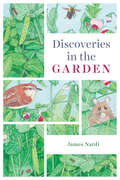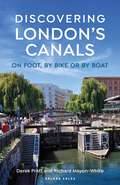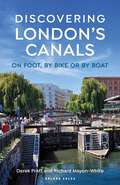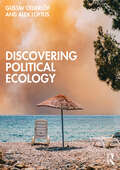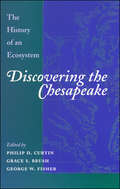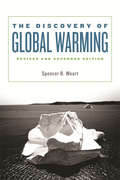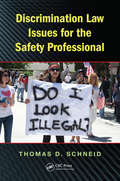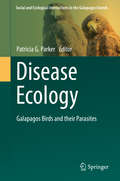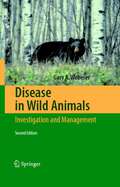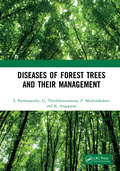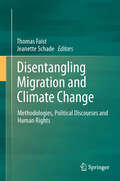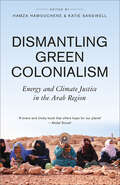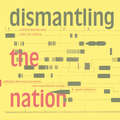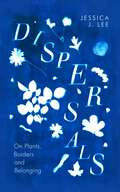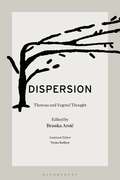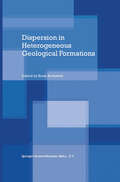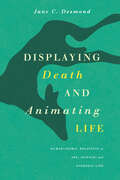- Table View
- List View
Discoveries in the Garden
by James B. NardiEvery square inch of soil is rich with energy and life, and nowhere is this more evident than in the garden. At the tips of our trowels, a sun-driven world of microbes, insects, roots, and stems awaits—and it is a world no one knows better than James Nardi. A charming guide to all things green and growing, Nardi is as at home in prairies, forests, and wetlands as he is in the vegetable patch. And with Discoveries in the Garden, he shows us that these spaces aren’t as different as we might think, that nature flourishes in our backyards, schoolyards, and even indoors. To find it, we’ve only got to get down into the dirt. Leading us through the garden gate, Nardi reveals the extraordinary daily lives and life cycles of a quick-growing, widely available, and very accommodating group of study subjects: garden plants. Through close observations and simple experiments we all can replicate at home, we learn the hidden stories behind how these plants grow, flower, set seeds, and produce fruits, as well as the vital role dead and decomposing plants play in nourishing the soil. From pollinators to parasites, plant calisthenics to the wisdom of weeds, Nardi’s tale also introduces us to our fellow animal and microbial gardeners, the community of creatures both macro- and microscopic with whom we share our raised beds. Featuring a copse of original, informative illustrations that are as lush as the garden plants themselves, Discoveries in the Garden is an enlightening romp through the natural history, science, beauty, and wonder of these essential green places.
Discoveries in the Garden
by James B. NardiEvery square inch of soil is rich with energy and life, and nowhere is this more evident than in the garden. At the tips of our trowels, a sun-driven world of microbes, insects, roots, and stems awaits—and it is a world no one knows better than James Nardi. A charming guide to all things green and growing, Nardi is as at home in prairies, forests, and wetlands as he is in the vegetable patch. And with Discoveries in the Garden, he shows us that these spaces aren’t as different as we might think, that nature flourishes in our backyards, schoolyards, and even indoors. To find it, we’ve only got to get down into the dirt. Leading us through the garden gate, Nardi reveals the extraordinary daily lives and life cycles of a quick-growing, widely available, and very accommodating group of study subjects: garden plants. Through close observations and simple experiments we all can replicate at home, we learn the hidden stories behind how these plants grow, flower, set seeds, and produce fruits, as well as the vital role dead and decomposing plants play in nourishing the soil. From pollinators to parasites, plant calisthenics to the wisdom of weeds, Nardi’s tale also introduces us to our fellow animal and microbial gardeners, the community of creatures both macro- and microscopic with whom we share our raised beds. Featuring a copse of original, informative illustrations that are as lush as the garden plants themselves, Discoveries in the Garden is an enlightening romp through the natural history, science, beauty, and wonder of these essential green places.
Discoveries in the Garden
by James B. NardiEvery square inch of soil is rich with energy and life, and nowhere is this more evident than in the garden. At the tips of our trowels, a sun-driven world of microbes, insects, roots, and stems awaits—and it is a world no one knows better than James Nardi. A charming guide to all things green and growing, Nardi is as at home in prairies, forests, and wetlands as he is in the vegetable patch. And with Discoveries in the Garden, he shows us that these spaces aren’t as different as we might think, that nature flourishes in our backyards, schoolyards, and even indoors. To find it, we’ve only got to get down into the dirt. Leading us through the garden gate, Nardi reveals the extraordinary daily lives and life cycles of a quick-growing, widely available, and very accommodating group of study subjects: garden plants. Through close observations and simple experiments we all can replicate at home, we learn the hidden stories behind how these plants grow, flower, set seeds, and produce fruits, as well as the vital role dead and decomposing plants play in nourishing the soil. From pollinators to parasites, plant calisthenics to the wisdom of weeds, Nardi’s tale also introduces us to our fellow animal and microbial gardeners, the community of creatures both macro- and microscopic with whom we share our raised beds. Featuring a copse of original, informative illustrations that are as lush as the garden plants themselves, Discoveries in the Garden is an enlightening romp through the natural history, science, beauty, and wonder of these essential green places.
Discoveries in the Garden
by James B. NardiEvery square inch of soil is rich with energy and life, and nowhere is this more evident than in the garden. At the tips of our trowels, a sun-driven world of microbes, insects, roots, and stems awaits—and it is a world no one knows better than James Nardi. A charming guide to all things green and growing, Nardi is as at home in prairies, forests, and wetlands as he is in the vegetable patch. And with Discoveries in the Garden, he shows us that these spaces aren’t as different as we might think, that nature flourishes in our backyards, schoolyards, and even indoors. To find it, we’ve only got to get down into the dirt. Leading us through the garden gate, Nardi reveals the extraordinary daily lives and life cycles of a quick-growing, widely available, and very accommodating group of study subjects: garden plants. Through close observations and simple experiments we all can replicate at home, we learn the hidden stories behind how these plants grow, flower, set seeds, and produce fruits, as well as the vital role dead and decomposing plants play in nourishing the soil. From pollinators to parasites, plant calisthenics to the wisdom of weeds, Nardi’s tale also introduces us to our fellow animal and microbial gardeners, the community of creatures both macro- and microscopic with whom we share our raised beds. Featuring a copse of original, informative illustrations that are as lush as the garden plants themselves, Discoveries in the Garden is an enlightening romp through the natural history, science, beauty, and wonder of these essential green places.
Discovering London's Canals: On foot, by bike or by boat
by Derek Pratt Richard Mayon-WhiteDiscover the beauty and delights of London's waterways, on foot or by boat, with Derek Pratt and Richard Mayon-White's fascinating and thorough guide.To really explore London's canals is to see the city in a way you've never seen it before. A different world, away from the hustle-bustle of overladen streets and towering skyscrapers, the waterways offer a unique paradise, full of wildlife, brightly coloured narrowboats, lush greenery and an environment steeped in history. Discovering London's Canals will open your eyes to this world and show you all it has to offer, walking with you along the vast stretches of each canal, pointing out the many sights to see and enjoy, pubs to quench your thirst in and history to marvel at. Enjoy whole days out with family and friends, or just an hour or two, choosing a stretch of canal and discovering so many sights and attractions either on or within a short walk from the water's edge. With information boxes, travel directions, clear maps and beautiful photography, along with insightful travel writing from the kings of the waterways, Derek Pratt and Richard Mayon-White, Discovering London's Canals is the perfect guide for anyone who loves walking, wildlife and the waterways of the great city of London. The book covers more than 60 miles of waterways in London, easy to get to and walkable for just an hour, an afternoon or a whole day, and each route is great for walking, running or cycling, with many traversable at any time of year. Go out there and see for yourself – there is a wonderful network of waterways just waiting to be explored in parts of London you hardly knew existed.
Discovering London's Canals: On foot, by bike or by boat
by Derek Pratt Richard Mayon-WhiteDiscover the beauty and delights of London's waterways, on foot or by boat, with Derek Pratt and Richard Mayon-White's fascinating and thorough guide.To really explore London's canals is to see the city in a way you've never seen it before. A different world, away from the hustle-bustle of overladen streets and towering skyscrapers, the waterways offer a unique paradise, full of wildlife, brightly coloured narrowboats, lush greenery and an environment steeped in history. Discovering London's Canals will open your eyes to this world and show you all it has to offer, walking with you along the vast stretches of each canal, pointing out the many sights to see and enjoy, pubs to quench your thirst in and history to marvel at. Enjoy whole days out with family and friends, or just an hour or two, choosing a stretch of canal and discovering so many sights and attractions either on or within a short walk from the water's edge. With information boxes, travel directions, clear maps and beautiful photography, along with insightful travel writing from the kings of the waterways, Derek Pratt and Richard Mayon-White, Discovering London's Canals is the perfect guide for anyone who loves walking, wildlife and the waterways of the great city of London. The book covers more than 60 miles of waterways in London, easy to get to and walkable for just an hour, an afternoon or a whole day, and each route is great for walking, running or cycling, with many traversable at any time of year. Go out there and see for yourself – there is a wonderful network of waterways just waiting to be explored in parts of London you hardly knew existed.
Discovering Political Ecology
by Gustav Cederlöf Alex LoftusPolitical ecology is one of the most vibrant fields of environmental research. This book introduces political ecology to a new generation of students in a daring new way: as an interdisciplinary approach to environmental research but also as a series of lived realities and a praxis for change. The origins of political ecology are often traced through an Anglo-American canon. In Discovering Political Ecology, Gustav Cederlöf and Alex Loftus instead take up the challenge of presenting the key conversations and the diverse traditions that have shaped this field with attention to its extensive international roots. Inspired by voices and research in Asia, Africa, Europe and the Americas, the authors address the concerns of those who from different social backgrounds have grown up in a world shaped by climate change and increasing environmental inequalities.Engaging and accessible in style, Discovering Political Ecology introduces a set of key concepts around which conversations in political ecology coalesce. It also shows how these concepts allow you to make sense of some of the most pressing issues of our time—issues around water, energy, agriculture, forestry, climate change and environmental justice. Each chapter includes learning outcomes and suggested further readings, extensive bibliographies and seminar activities to be used by students and educators. At the cutting edge of the field, the book will be of interest to those in all disciplines brought together in political ecology, including but not limited to anthropology, development studies, ecology, geography, history and political science.
Discovering Political Ecology
by Gustav Cederlöf Alex LoftusPolitical ecology is one of the most vibrant fields of environmental research. This book introduces political ecology to a new generation of students in a daring new way: as an interdisciplinary approach to environmental research but also as a series of lived realities and a praxis for change. The origins of political ecology are often traced through an Anglo-American canon. In Discovering Political Ecology, Gustav Cederlöf and Alex Loftus instead take up the challenge of presenting the key conversations and the diverse traditions that have shaped this field with attention to its extensive international roots. Inspired by voices and research in Asia, Africa, Europe and the Americas, the authors address the concerns of those who from different social backgrounds have grown up in a world shaped by climate change and increasing environmental inequalities.Engaging and accessible in style, Discovering Political Ecology introduces a set of key concepts around which conversations in political ecology coalesce. It also shows how these concepts allow you to make sense of some of the most pressing issues of our time—issues around water, energy, agriculture, forestry, climate change and environmental justice. Each chapter includes learning outcomes and suggested further readings, extensive bibliographies and seminar activities to be used by students and educators. At the cutting edge of the field, the book will be of interest to those in all disciplines brought together in political ecology, including but not limited to anthropology, development studies, ecology, geography, history and political science.
Discovering the Chesapeake: The History of an Ecosystem
by George W. FisherWith its rich evolutionary record of natural systems and long history of human activity, the Chesapeake Bay provides an excellent example of how a great estuary has responded to the powerful forces of human settlement and environmental change. Discovering the Chesapeake explores all of the long-term changes the Chesapeake has undergone and uncovers the inextricable connections among land, water, and humans in this unusually delicate ecosystem.Edited by a historian, a paleobiologist, and a geologist at the Johns Hopkins University and written for general readers, the book brings together experts in various disciplines to consider the truly complex and interesting environmental history of the Chesapeake and its watershed. Chapters explore a variety of topics, including the natural systems of the watershed and their origins; the effects of human interventions ranging from Indian slash-and-burn practices to changing farming techniques; the introduction of pathogens, both human and botanical; the consequences of the oyster's depletion; the response of bird and animal life to environmental factors introduced by humans; and the influence of the land and water on the people who settled along the Bay.Discovering the Chesapeake, originating in two conferences sponsored by the National Science Foundation, achieves a broad historical and scientific appreciation of the various processes that shaped the Chesapeake region."Today's Chesapeake Bay is only some ten thousand years old. What a different world it was... when the region was the home of the ground sloth, giant beaver, dire wolf, mastodon, and other megafauna. In the next few thousand years, the ice may form again and the Bay will once more be the valley of the Susquehanna, unless, of course, human-induced changes in climate create some other currently unpredictable condition."—from the Introduction
The Discovery of Global Warming: Revised and Expanded Edition (New histories of science, technology, and medicine #13)
by Spencer R. WeartThe award-winning book is now revised and expanded. In 2001 an international panel of distinguished climate scientists announced that the world was warming at a rate without precedent during at least the last ten millennia, and that warming was caused by the buildup of greenhouse gases from human activity. The story of how scientists reached that conclusion—by way of unexpected twists and turns—was the story Spencer Weart told in The Discovery of Global Warming. Now he brings his award-winning account up to date, revised throughout to reflect the latest science and with a new conclusion that shows how the scientific consensus caught fire among the general world public, and how a new understanding of the human meaning of climate change spurred individuals and governments to action.
Discrimination Law Issues for the Safety Professional
by Thomas D. SchneidSafety professionals communicate, directly and indirectly with a large number of employees and others on a daily basis. While not lawyers, they regularly deal with legal issues. A subset of their responsibilities includes how to discuss safety without crossing the discriminatory line. To do this, they need an understanding of discrimination laws. D
Disease Ecology: Galapagos Birds and their Parasites (Social and Ecological Interactions in the Galapagos Islands)
by Patricia G. ParkerThis book provides the first collection of chapters written by scientists who have contributed to the understanding of disease ecology in the Galapagos Islands, an iconic and historic natural site. The Galapagos Archipelago straddles the equator in the eastern Pacific Ocean, almost 1000 km off the coast of Ecuador, and includes 13 major islands, numerous smaller satellite islands, and many more even smaller islets. The wildlife on the Galapagos Islands today represents one of the best-preserved wild communities of plants and animals in the world, owing to the location of the islands at the intersection of major ocean currents, the commitment by Ecuador for the vast majority of the area to be left undeveloped, and the protection provided by the Galapagos National Park. Most of the animal species in Galapagos are endemic, occurring nowhere else. But they are descendants of ancestors that colonized earlier, and then, isolated from their mainland origins, evolved into forms that are recognized as distinct today. Since 2001, many of the authors of this book have been part of a four-institution partnership investigating the threats posed by pathogens to Galapagos avifauna. They approach the topic of disease ecology in a novel manner, starting with the history of arrival of both the birds themselves and the pathogens. This synthetic approach requires the integration of themes from veterinary medicine, epidemiology, population genetics, and phylogenetics.
Disease in Wild Animals: Investigation and Management
by Gary A. WobeserGary Wobeser's successful book from 1994 has been completely updated and enlarged in a new second edition. An in-depth overview of the available techniques for the investigation and management of disease in free-ranging animals is provided. The subjects are illustrated with examples drawn from around the world, with emphasis on the special requirements involved in working with wild animals. The book draws on the author’s training as a wildlife biologist.
Diseases of Forest Trees and their Management
by S. Parthasarathy G. Thiribhuvanamala P. Muthulakshmi K. AngappanThe book is intended to provide comprehensive introduction to the important aspects of the field of forest pathology and tree diseases. The book is arranged in two major parts. The fundamental chapters, present forest diseases, pathogens, epidemics, and management that is applicable to all forest trees. The applied chapters on the individual crops that are grouped alphabetically present information on the symptoms, pathogen and integrated management of major diseases of forest trees. It was designed to give a broad overview of the field of forest pathology but with sufficient detail that they will be able to assess their specific role as practicing forestry professionals.Note: T& F does not sell or distribute the Hardback in India, Pakistan, Nepal, Bhutan, Bangladesh and Sri Lanka.
Diseases of Forest Trees and their Management
by S. Parthasarathy G. Thiribhuvanamala P. Muthulakshmi K. AngappanThe book is intended to provide comprehensive introduction to the important aspects of the field of forest pathology and tree diseases. The book is arranged in two major parts. The fundamental chapters, present forest diseases, pathogens, epidemics, and management that is applicable to all forest trees. The applied chapters on the individual crops that are grouped alphabetically present information on the symptoms, pathogen and integrated management of major diseases of forest trees. It was designed to give a broad overview of the field of forest pathology but with sufficient detail that they will be able to assess their specific role as practicing forestry professionals.Note: T& F does not sell or distribute the Hardback in India, Pakistan, Nepal, Bhutan, Bangladesh and Sri Lanka.
Disentangling Migration and Climate Change: Methodologies, Political Discourses and Human Rights
by Thomas Faist and Jeanette SchadeThis book addresses environmental and climate change induced migration from the vantage point of migration studies, offering a broad spectrum of approaches for considering the environment/climate/migration nexus. Research on the subject is still frequently narrowed down to climate change vulnerability and the environmental push factor. The book establishes the interconnections between societal and environmental vulnerability, and migration and capability, allowing appreciation of migration in the frame of climate as a case of spatial and social mobility, that is, as a strategy of persons and groups to deal with a grossly unequal distribution of life chances across the world. In their introduction, the editors fan out the current debate and state the need to transcend predominantly policy-oriented approaches to migration. The first section of the volume focuses on “Methodologies and Methods” and presents very distinct approaches to think climate induced migration. Subsequent chapters explore the sensitivity of existing migration flows to climate change in Ghana and Bangladesh, the complex relationship between migration, demographic change and coping capacities in Canada, methodological challenges of a household survey on the significance of migration and remittances for adaptation in the Hindu Kush region and an econometric study of the aftermath of the 1998 floods in Bangladesh. The second part, “Areas of Concern: Politics and Human Rights”, deepens the analysis of discourses as well as of the implications of proposed and implemented policies. Contributors discuss such topics as environmental migration as a multi-causal problem, climate migration as a consequence in an alarmist discourse and climate migration as a solution. A study of an integrated relocation program in Papua New Guinea is followed by chapters on the promise and the flaws of planned relocation policy, global policy on protection of environmental migrants including both internally displaced peoples and those who cross international borders. A concluding chapter places human agency at centre stage and explores the interplay between human rights, capability and migration.
Disguise: A Novel
by Hugo HamiltonHugo Hamilton, the internationally acclaimed author of ‘The Speckled People’ and ‘Sailor in the Wardrobe’, turns his hand back to fiction with a compelling drama tracing Berlin's central historical importance throughout the twentieth century.
Diskursive Dynamiken und Policy-Wandel in der EU-Energiepolitik: Eine Blended-Reading-Diskursanalyse des ordentlichen Gesetzgebungsverfahrens der EU von 1992 bis 2019 (Studien der NRW School of Governance)
by Tobias RammelWie lässt sich Policy-Wandel in der Europäischen Union erklären? Tobias Rammel beantwortet diese Frage erstmals für die Gesamtheit des ordentlichen Gesetzgebungsverfahrens zur EU-Energiepolitik von 1992 bis 2019 im Rahmen einer Blended-Reading-Diskursanalyse. Rekurrierend auf eine Analyse des Forschungsstandes zur EU-Energiepolitik wird in diesem Buch argumentiert, dass eine theoretische Synthese der Arbeiten zur Diskursanalyse und zum Policy-Wandel die bisherigen Defizite der klassischen Theorieschulen ausgleichen kann. Methodisch wird in einem innovativen dreistufigen Forschungsdesign auf eine Blended-Reading-Kombination von Close-Reading in Form von unüberwachten Text-Mining-Verfahren (Topic Modeling) zur induktiv-explorativen Vorstrukturierung der Analyse und Distant-Reading in Form einer qualitativen Feinanalyse zur Interpretation und Kontextualisierung der Daten zurückgegriffen. Damit liefert das Buch eine bislang einzigartige und differenzierte Erklärung für Policy-Wandel und die dazugehörigen diskursiven Dynamiken zwischen den EU-Institutionen im COD der EU-Energiepolitik von 1992 bis 2019.
Dismantling Green Colonialism: Energy and Climate Justice in the Arab Region
by Hamza Hamouchene and Katie Sandwell‘A thought-provoking book which empowers its readers to think about the problems in systematic, transformative ways’ Fadhel Kaboub, President of the Global Institute for Sustainable Prosperity‘A much-needed decolonial examination of the climate crisis’ Nnimmo Bassey, author of To Cook a Continent‘Groundbreaking ... offers a timely, acute analysis of what a just transition might mean for the region’ Laleh Khalili, author of Sinews of War and TradeThe Arab region is a focus of world politics, with authoritarian regimes, significant fossil fuel reserves and histories of colonialism and imperialism. It is also the site of potentially immense green energy resources.The writers in this collection explore a region ripe for energy transition, but held back by resource-grabbing and (neo)colonial agendas. They show the importance of fighting for a just energy transition and climate justice – exposing policies and practices that protect global and local political elites, multinational corporations and military regimes.Covering a wide range of countries from Morocco, Algeria and Tunisia to Egypt, Sudan, UAE, Saudi Arabia, Jordan and Palestine, this book challenges Eurocentrism and highlights instead a class-conscious approach to climate justice that is necessary for our survival.Hamza Hamouchene is a London-based Algerian researcher and activist. He is the North Africa Programme Coordinator at the Transnational Institute (TNI). His books include The Arab Uprisings and The Struggle for Energy Democracy in the Maghreb. He writes for various publications including the Guardian, HuffPost and openDemocracy. Katie Sandwell is a Programme Coordinator with the Transnational Institute. She is co-author of From Crisis to Transformation: What is Just Transition?
Dismantling the Nation: Contemporary Art in Chile
by Florencia San MartínThe first volume to theorize and historicize contemporary artistic practices from Chile in the English language, Dismantling the Nation begins from a position of radical criticism against the nation-state of Chile and its capitalist, heteronormative, and extractivist rule. At a truly pivotal moment in the country’s history, when it is redefining what it wants to be, the works here propose a way of forging a feminist and decolonial future for Chile. The authors attend to practices from distinct locations in Chile, reconceptualizing geographical borders from a transnational and transdisciplinary perspective while engaging with ecocriticism and Indigenous epistemologies. This is an essential volume for anyone looking to understand the current social, political, and artistic movements in Chile.
Dispersals: On Plants, Borders and Belonging
by Jessica J. Lee‘An invigorating cross-pollination of memoir and natural history, both beautifully phrased and delicately structured—this book deserves your time and attention’ Cal Flyn, author of Islands of Abandonment A poetic and intimate essay collection on the lives of plants and their entanglement with our human worldsA seed slips beyond a garden wall. A seaweed drifts through an ocean. A tree is planted on a shifting border. A shrub is uprooted from its culture and its land. What happens when these plants leave their original homes and put down roots elsewhere?Born in Canada to a Taiwanese mother and a Welsh father, steeped in both literary and scientific traditions, Jessica J. Lee is a perfectly placed observer of our world in motion.In this vibrant book of linked essays she explores the entanglements of the plant and human worlds, and the echoes and counterpoints she detects in the migration of plants and people - and the language we use to describe them.Each of the plants considered in this collection are somehow perceived as being "out of place"- whether weeds, samples collected through imperial science, or crops introduced and transformed by our hand.Combining memoir, history, and scientific research in precise and poetic prose, Jessica J. Lee meditates on the question of how both plants and people come to belong - or not - as they border cross, and reveals how all our futures are more entwined than we might imagine.'At once expansive and intimate, and most of all, gorgeously written. This is a book I will return to often over the course of my life’ Nina Mingya Powles, author of Small Bodies of Water
Dispersion: Thoreau and Vegetal Thought
by Branka ArsićPlants are silent, still, or move slowly; we do not have the sense that they accompany us, or even perceive us. But is there something that plants are telling us? Is there something about how they live and connect, how they relate to the world and other plants that can teach us about ecological thinking, about ethics and politics? Grounded in Thoreau's ecology and in contemporary plant studies, Dispersion: Thoreau and Vegetal Thought offers answers to those questions by pondering such concepts as co-dependence, the continuity of life forms, relationality, cohabitation, porousness, fragility, the openness of beings to incessant modification by other beings and phenomena, patience, waiting, slowness and receptivity.
Dispersion: Thoreau and Vegetal Thought
Plants are silent, still, or move slowly; we do not have the sense that they accompany us, or even perceive us. But is there something that plants are telling us? Is there something about how they live and connect, how they relate to the world and other plants that can teach us about ecological thinking, about ethics and politics? Grounded in Thoreau's ecology and in contemporary plant studies, Dispersion: Thoreau and Vegetal Thought offers answers to those questions by pondering such concepts as co-dependence, the continuity of life forms, relationality, cohabitation, porousness, fragility, the openness of beings to incessant modification by other beings and phenomena, patience, waiting, slowness and receptivity.
Dispersion in Heterogeneous Geological Formations
by Brian BerkowitzIn spite of many years of intensive study, our current abilities to quantify and predict contaminant migration in natural geological formations remain severely limited. The heterogeneity of these formations over a wide range of scales necessitates consideration of sophisticated transport theories. The evolution of such theories has escalated to the point that a review of the subject seems timely. While conceptual and mathematical developments were crucial to the introduction of these new approaches, there are now too many publications that contain theoretical abstractions without regard to real systems, or incremental improvements to existing theories which are known not to be applicable. This volume brings together articles representing a broad spectrum of state-of-the-art approaches for characterization and quantification of contaminant dispersion in heterogeneous porous media. Audience: The contributions are intended to be as accessible as possible to a wide readership of academics and professionals with diverse backgrounds such as earth sciences, subsurface hydrology, petroleum engineering, and soil physics.
Displaying Death and Animating Life: Human-Animal Relations in Art, Science, and Everyday Life (Animal Lives)
by Jane C. DesmondThe number of ways in which humans interact with animals is almost incalculable. From beloved household pets to the steak on our dinner tables, the fur in our closets to the Babar books on our shelves, taxidermy exhibits to local zoos, humans have complex, deep, and dependent relationships with the animals in our ecosystems. In Displaying Death and Animating Life, Jane C. Desmond puts those human-animal relationships under a multidisciplinary lens, focusing on the less obvious, and revealing the individualities and subjectivities of the real animals in our everyday lives. Desmond, a pioneer in the field of animal studies, builds the book on a number of case studies. She conducts research on-site at major museums, taxidermy conventions, pet cemeteries, and even at a professional conference for writers of obituaries. She goes behind the scenes at zoos, wildlife clinics, and meetings of pet cemetery professionals. We journey with her as she meets Kanzi, the bonobo artist, and a host of other animal-artists—all of whom are preparing their artwork for auction. Throughout, Desmond moves from a consideration of the visual display of unindividuated animals, to mourning for known animals, and finally to the marketing of artwork by individual animals. The first book in the new Animal Lives series, Displaying Death and Animating Life is a landmark study, bridging disciplines and reaching across divisions from the humanities and social sciences to chart new territories of investigation.
